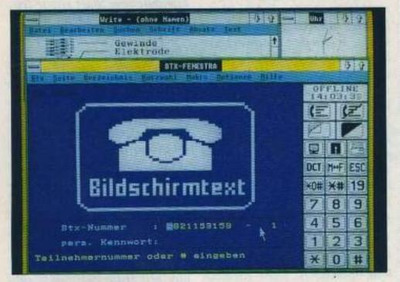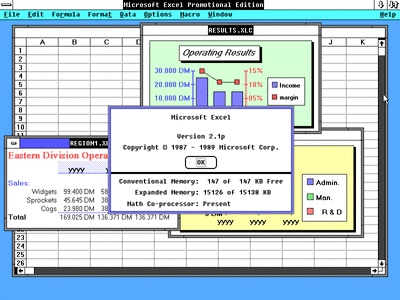Thanks for browsing by doshea!! ^^
Personally, I have a soft spot for Windows 2.03, because that's what I had access to in my childhood, along with Windows 3.1.
I played many games of Klotz, a Tetris style game by a fellow citizen.
It's also interesting, because it's from the 1980s, a great decade.
Personally, I believe that there used to be a lot of early Windows software written for Windows 2 and Windows/386 in particular.
To my knowledge, these early applications were written using the original MS Windows SDK and Windows.h file.
I draw this conclusion, because Windows 1 and 2 were both very insignificant still when they were new.
Only a few users knew of Windows and applications were rare.
The programs shipped were worth the buy alone already.
And interested developers were already satisfied if they got their hands on the Windows SDK.
They didn't really differentiate between the few versions available because
a) they probably didn't know about their existence
b) only found a programming book about Windows 1.0 in their local library
c) saw the biggest feature of Windows 2.x in the overlapping windows.
Which as such didn't cause a major change, as far as the SDK was being concerned.
Most Windows 1.x programs can be resized on Windows 2.x, afaik.
The resource files of 1.x and 2.x were quite similar, still, as well.
The upcoming Windows 3.0 was another beast, by contrast.
Which brings me to the next point, which I can barely prove, though.
To what I've found evidences for, many Windows 3.0 programs were derivatives of Windows 2 or Windows/386 programs.
And after Windows 3.0 was out, they had been eradicated by Windows 3.0 compatible successors:
When Hobbes and other places started out, it was already too late.
My best bet are companion diskettes, book ware, that shipped with old magazines and books released before 1990.
They might be the last witnesses of the early days of Windows.
That replacement took place because the resource format and API in Windows 3.0 was so drastically different.
Applications not ported to Windows 3.0 did trigger a compatibility warning often.
Unless they were manually modified using MARK utility (or MARK30, a freeware utility).
Windows 2.x programs that are "clean", ie don't do segment arithmetics and support scalable fonts,
can run stable under both Windows 2.x and Windows 3.0+. There's a provision in the NE header for that.
However, quite a few developers seemed to go another route instead
and did create native Windows 3.0 applications instead, never looking back.
Those application did nolonger need Windows 3.x to load its compatibility module
(winoldap.mod, Windows Old Application Support Module).
And that's why it's so hard finding evidences about Windows 2.x applications, I believe.
The copyright dates in many programs are one of those, though.
They date back to before 199o, when Windows 3.0 was released.
In addition, some 1980s computer magazines did contain screenshots of early Windows applications.
Attached below is one screenshot of a special terminal program once required
to access the German equivalent to French Minitel/Telétel online service.
Edit: I forget to mention. You can find a few shareware programs for Windows 1.x and 2.x at Toasty Tech page.
It also has a gallery with lots of information about old GUIs in general.
"Time, it seems, doesn't flow. For some it's fast, for some it's slow.
In what to one race is no time at all, another race can rise and fall..." - The Minstrel
//My video channel//

